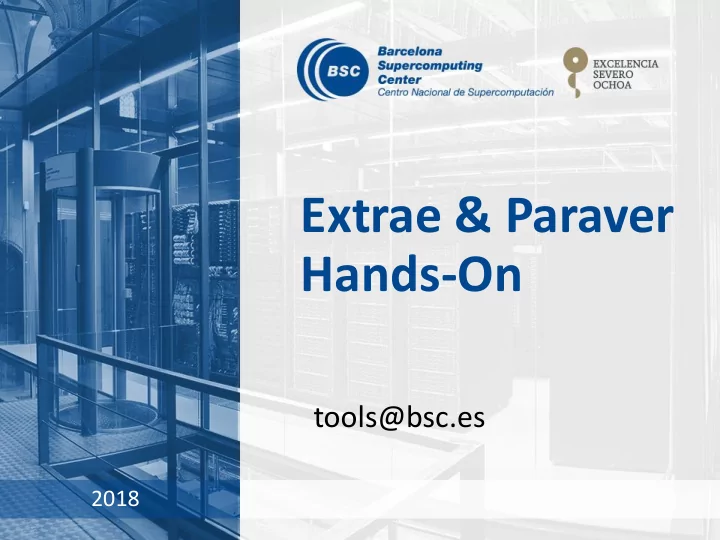

Extrae & Paraver Hands-On tools@bsc.es 2018
Copy files for the hands-on • You can download the material for most of the hands on from the web site https://tools.bsc.es/tools-hands-on. • No binaries are provided, but you can follow the Extrae part with your own code. > ls -l tools-material … clustering/ … dimemas/ … extrae/ … traces/ 2
Using Extrae in 3 steps 1. Adapt your job submission scripts 2. Configure what to trace (optional) • XML configuration file • Example configurations at $EXTRAE_HOME/share/example 3. Run it! • For further reference check the Extrae User Guide: • https://tools.bsc.es/sites/default/files/documentation/html/extrae/index.html • Also distributed with Extrae at $EXTRAE_HOME/share/doc 3
Step 1: Adapt the job script to load Extrae (LD_PRELOAD) > vi tools-material/extrae/job_27p.sh job_27p.sh #!/bin/bash # @ initialdir = . # @ output = lulesh2_27p.out # @ error = lulesh2_27p.err Request resources # @ total_tasks = 27 # @ cpus_per_task = 1 # @ wall_clock_limit = 00:10:00 Run the program mpirun -np 27 ./lulesh2.0 -i 10 -s 65 4
Step 1: Adapt the job script to load Extrae (LD_PRELOAD) > vi tools-material/extrae/job_27p.sh job_27p.sh #!/bin/bash # @ initialdir = . # @ output = lulesh2_27p.out # @ error = lulesh2_27p.err # @ total_tasks = 27 # @ cpus_per_task = 1 # @ wall_clock_limit = 00:10:00 Load Extrae module load extrae TRACE_NAME=lulesh2_27p.prv Activate Extrae mpirun -np 27 ./trace.sh ./lulesh2.0 – i 10 -s 65 in the execution 5
Step 1: Adapt the job script to load Extrae (LD_PRELOAD) > vi tools-material/extrae/trace.sh Select trace.sh “ what to trace” #!/bin/bash #!/bin/bash # @ initialdir = . # Configure Extrae # @ output = lulesh2_27p.out export EXTRAE_CONFIG_FILE=./extrae.xml # @ error = lulesh2_27p.err # @ total_tasks = 27 # Load the tracing library (choose C/Fortran) # @ cpus_per_task = 1 export LD_PRELOAD=${EXTRAE_HOME}/lib/libmpitrace.so # @ wall_clock_limit = 00:10:00 #export LD_PRELOAD=${EXTRAE_HOME}/lib/libmpitracef.so # Run the program module load extrae $* TRACE_NAME=lulesh2_27p.prv mpirun -np 27 ./trace.sh ./lulesh2.0 – i 10 -s 65 Select your type of application 6
Step 1: Which tracing library? • Choose depending on the application type Library Serial MPI OpenMP pthread CUDA libseqtrace libmpitrace[f] 1 libomptrace libpttrace libcudatrace libompitrace[f] 1 libptmpitrace[f] 1 libcudampitrace[f] 1 1 include suffix “f” in Fortran codes 7
Step 3: Run it! • Submit your job > cd tools-material/extrae > qsub job_27p.sh 8
All done! Check your resulting trace • Once finished you will have the trace (3 files): > ls – l tools-material/extrae ... lulesh2_27p.pcf lulesh2_27p.prv lulesh2_27p.row • To proceed with the example traces already generated here: > ls tools-material/traces • Now let’s look into it ! 9
Install Paraver • Download from https://tools.bsc.es/downloads Pick your version wxparaver-4.7.2-win.zip wxparaver-4.7.2-mac.zip wxparaver-4.7.2-Linux_i686.tar.gz (32-bits) wxparaver-4.7.2-Linux_x86_64.tar.gz (64-bits) 10
Install Paraver (II) • Download tutorials: • Documentation • Tutorial guidelines Download links 11
Uncompress, rename & move • Command-line > tar xf wxparaver-4.7.2-linux-x86_64.tar.gz > mv wxparaver-4.6.2-linux-x86_64 paraver > tar xf paraver-tutorials-20150526.tar.gz > mv paraver-tutorials-20150526 paraver/tutorials 12
Check that everything works • Start Paraver > paraver/bin/wxparaver • Check that tutorials are available Click on Help Tutorials 13
First steps of analysis • Load the trace with Paraver Click on File Load Trace Browse to “lulesh2_27p.prv” • Follow Tutorial #3 • Introduction to Paraver and Dimemas methodology Click on Help Tutorials 14
Measure the parallel efficiency • Click on “ mpi_stats.cfg ” • Check the Average for the column labeled “ Outside MPI ” Parallel efficiency Comm efficiency Load balance 15
Computation load & time distribution • Click on “2dh_usefulduration.cfg” (2nd link) Shows time computing Time imbalance (zig-zag) Sockets with Sockets with 4 processes 5 processes 16
Computation load & time distribution • Click on “2dh_useful_instructions.cfg” (3rd link) Shows amount of work Perfect work distribution (straight line) Work imbalance (zig-zag) 17
Where does this happen? • Go from the table to the timeline 1. Click on “Open Filtered Control Window ” Select this area (by drag-and-dropping)
Where does this happen? Right click Fit Semantic Scale Fit both Zoom into 1 of the iterations (by drag-and-dropping)
Where does this happen? • & at the same time? Imbalance Slow Fast • Reference to the source code: Hints Callers Caller function CommSend CommMonoQ TimeIncrement 20
Save CFG’s (2 methods) • From the contextual menu 1. Right click on timeline 21
Save CFG’s (2 methods) • From Paraver main window 2. Main Paraver window 2. Select 3. Save 22
CFG’s distribution • Paraver comes with many more included CFG’s 23
Hints: a good place to start! • Paraver suggests CFG’s based on the information present in the trace 24
Recommend
More recommend